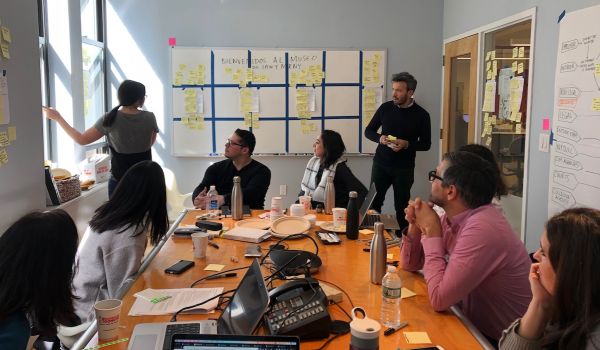Over the past few years a merry band of geeks from around the world has given rise to the movement of the quantified self. The mission, as the geeks explain it, is “self knowledge through numbers.” Vanity Fair sarcastically calls them “weirder, hive minder weight watchers.”
The basic premise of the quantified self is perhaps best summed up by a popular slogan from business consultant Peter Drucker: “What gets measured gets managed.” If we aspire to run faster, then we must use a stopwatch to time our pace. If we want to lose weight, then we must buy a scale to measure our progress until we reach our goal. Modern self-trackers have the advantages of apps that make it possible to quantitatively analyze sleep, moods, finances, vital signs and even amino acids, all without consulting a single other person.
The rise of the quantified self is indicative of our more general obsession with data, but it also illustrates our growing concern with personal perfection at the expense of community well being. Popular books, like Timothy Ferriss’ 4-Hour Workweek, advise readers to shut out the distractions of the wider world in order to focus entirely on self-improvement and personal perfection.
The Quantified City
What if we were to apply the model of the quantified self to the development of our cities? It’s a question that appears to be gaining steam. Esther Dyson, an influential angel investor and technology analyst, has observed the emergence of a suite of applications that enable citizens and governments to monitor the “health” of their communities.
Civic Insight, for example, has partnered with New Orleans to enable citizens to monitor what the local government is doing to address blight. On Monday, the project was announced as one of eight winners of the 2013 Knight News Challenge, which means that the software will be expanding for use in other cities. Yelp has partnered with New York and San Francisco to make restaurant inspection data available on restaurant profile pages. (Boston, Philadelphia and Chicago have already committed to making their restaurant inspection data available using the same standard.) The Daily Brief allows residents of Baltimore, Bloomington and Boston to monitor all the 311 service requests made by citizens each day.
GreatSchools is to schools what Yelp is to restaurants — it offers parents comprehensive profiles of local schools, including detailed information about test scores, enrollment statistics, student demographics and annual budgets. Each school profile on GreatSchools even incorporates data from Zillow so that parents can search for available homes in the best districts. Another 2013 Knight News Challenge winner, OpenCounter, helps local businesses navigate their cities’ permitting processes, so they can set up shop with a minimum of bureaucratic hassle.
These platforms can empower citizens in two ways. First, citizens can make better decisions about everything from the most expedient way to open their dream business to where to send their children to school, buy a home or eat lunch. (The Yelp connection goes beyond avoiding restaurants with poor inspection scores; researchers have also found a correlation between Yelp ratings for hospitals and lower patient readmission and mortality rates.) Second, such platforms are tools that empower citizens and civil society organizations to monitor the performance and spending of public services to demand for greater accountability.
The so-called “smart city” has until now been defined by companies like Cisco, Siemens and IBM, which sell public officials a vision of future cities that are fully automated by a network of intelligent sensors. However, these companies are less interested in empowering citizens to make better decisions and participate more meaningfully in the governance of their communities. Now, a growing number of social critics and urban planners are speaking out against the smart city
“No one likes a city that’s too smart,” notes the sociologist Richard Sennett in an essay that lambasts the smart city prototypes of Masdar City and Songdo. Writing in the Boston Globe, author Courtney Humphries collected the various arguments of critics of the “too-smart city.” These critics remind us that we have already tried to build smart cities from scratch using the latest technologies of the past, and that those failures should serve as warning signs as cities invest billions of dollars in top-down projects based on the technologies of today.
As Humphries reminds us, during the 1950s — at opposite ends of the earth — two architects designed the smart cities of their time: Oscar Niemeyer’s Brasilia, the capital of Brazil, and Le Corbusier’s Chandigarh, a symbol of newly independent, modern India. These two built-from-scratch cities — like the postwar suburbs that mushroomed throughout North America and Western Europe — centered on a new technology of the day: the automobile. Today both cities are case studies in the failures of 20th-century planning. Brasilia is among the world’s least walkable places and Chandigarh has more cars per person than any other Indian city.
Like today’s palm-sized computers, the automobile of the 1950s was the symbol of freedom, modernity and convenience. But neither Niemeyer nor Le Corbusier — nor the majority of urban planners of their generation — foresaw that car-centered city planning would result in gridlock, pollution, road rage, drunk driving and social isolation. The failures of car-centered urban planning should serve as notes of caution for cities that want to develop around specific technologies.
Like the car that allows us to more easily navigate long distances and unfamiliar routes, smart city technologies make it easier for us to fulfill daily needs more efficiently. Nest, developed by former Apple engineers, keeps us aware of how much energy we are using and how that compares to our neighbors. Smart sprinklers connected to a weather feed take into account tomorrow’s rainstorm before soaking our plants today. For the most part, this is great news. Who wants to waste limited cognitive energy in thinking out the most efficient watering schedule or reducing energy consumption?
Yet there is a risk here. As our lives become more automated, will we follow the guidance of our smart phones without reflecting on unintended consequences? In more specific terms, could the smart city paradigm draw attention and resources to those issues that can be easily quantified and calculated — for example, how to most efficiently reroute traffic — at the expense of complex issues that aren’t easily quantified, such as how to create public spaces that promote social inclusion?
Smart Citizens
These are questions that require humans to answer. In her critique of the “too-smart city,” Humphries points to Boston’s Office of New Urban Mechanics as a “deliberate counterweight to the heavy-handed, control-room vision of urban technology.” The office of New Urban Mechanics focuses on “participatory urbanism” as a way to involve citizens in the planning of their city and improvement of their communities. Similar initiatives have launched in Philadelphia, San Francisco (where citizens help the city government improve access to healthy food or reduce its environmental footprint) and New York (where a grassroots group of residents reimagines blighted public spaces as opportunities for so-called “placemaking”).
In Latin America, similar concerns led to the Latin American Network for Sustainable, Democratic and Just Cities. The network of more than 70 different citizen groups offers another way to involve residents in the improvement of their communities.
Often tied to a local university, the network partners track 100 basic indicators from official government data sources. The indicators range from the average percentage of income spent on housing to the amount of green space per resident to statistics about employment, pollution, commute times, health, education, equality and public safety.
In addition to information from official government sources, such as census data, the citizen observatories also contract with a polling company to survey a representative sample of the city’s population to document their perceptions of quality of life. This methodology emphasizes the importance of citizen perception. It’s not enough for a city’s homicide rate to fall; citizens need to feel safer as well. In Brazil, more than 500 mayoral candidates signed agreements to work hand-in-hand with the network when drafting their city plans and monitoring their implementation.
From Open Data to Actionable Knowledge
There is an important difference between data and knowledge. Data must be interpreted within specific contexts and compared to relevant points of reference. Knowledge informs our decisions and behavior. Over the past few years there has been a strong push to increase the supply of open data, but our ability to transform such data into actionable knowledge has not caught up.
It is for this reason that Socrata, one of the leading providers of open data portals for governments, recently introduced GovStat as a way to create performance dashboards from government datasets. The tool aims to give meaning to data by comparing performance over time and across geographies.
The GovStat platform took its inspiration from CitiStat, an award-winning governance program that began in Baltimore in 2000. When Martin O’Malley took over as mayor of Baltimore in December 1999, he wanted to know why the city suffered from such high rates of absenteeism. Within months he implemented CitiStat to monitor sick leave, overtime and absenteeism in real time. During the first year of the program, the city saved $13.2 million and within three years overtime fell by 40 percent and absenteeism fell by up to 50 percent in some agencies. Again, what gets measured gets managed.
Soon the platform expanded to track other performance indicators, from pothole abatement to trash collection, snow removal, illegal dumping, vacant buildings and sewage overflows. Researchers that have studied the impact of CitiStat in Baltimore stress the importance of strong support from the city’s leadership, beginning with O’Malley. Every week the heads of each city agency were required to sit down with O’Malley’s top staff to review the latest numbers from the CitiStat dashboard and adjust their practices accordingly. The data also helped inform new policies, such as a waste removal program that increased recycling by 53 percent.
When O’Malley became governor of Maryland in 2007, he implemented StateStat, a public-facing platform with clear, quantifiable goals and status reports that admit when insufficient progress is being made.
All this is wonderful in theory. But as it turns out, reality is more complicated. If you’ve watched The Wire, you may be familiar with the critique that CitiStat caused teachers and police officers to “juke the stats” without improving the quality of teaching or policing.
A 2010 survey of retired New York Police Department captains illustrated the critique when more than 100 respondents said they felt pressure to manipulate crime statistics in order to show reductions in reported crimes under the city’s CompStat program. (Though Heather MacDonald, writing in City Journal, questions the survey results and notes that crime reclassification dropped from 4.4 percent in 2000 to 1.5 percent in 2009.)
Regardless of the extent to which public workers feel compelled to alter data in order to achieve goals, we must recognize that quantified indicators are only proxies for complex phenomena that remain difficult to describe in numbers. A quality education can’t be wholly reflected in standardized test results, just as the quality of healthcare at a hospital can’t be fully assessed using readmission and mortality rates. Still, these numbers — if collected and reported accurately — serve as important proxies that empower citizens to make better decisions and to ensure that public services meet the needs of those they are meant to serve.
The quantified city is built on data, but ultimately comes down to communication. Numbers must be recognized as just another part of the ongoing conversation of our cities. Imagine a government that doesn’t only share its performance indicators and goals with the public, but invites the public to weigh in on how the data reflects reality and what still needs analysis or improvement.
Imagine a city environmental agency that works with high schools and universities to track water, noise and light pollution, and then works together with these schools on reduction solutions. Not only is this possible today, but it is affordable and technically unsophisticated. Much like the self-monitoring of the quantified self, all it requires is commitment and persistence.
David Sasaki is principal of investments at Omidyar Network, the philanthropic investment firm of eBay founder Pierre Omidyar, where he manages a portfolio of for-profit and non-profit organizations that enable civic participation and promote greater transparency and accountability in Latin America. He lives in Mexico City.
















